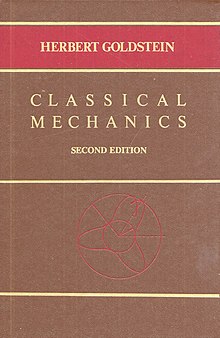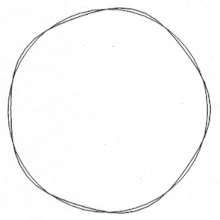Goldstein H 1980 Classical Mechanics (Reading, Massachusetts: Addisonwesley).
 Front comprehend of the third edition | |
| Author | Herbert Goldstein |
|---|---|
| State | Us of America |
| Language | English |
| Subject area | Classical mechanics |
| Genre | Not-fiction |
| Publisher | Addison-Wesley |
| Publication date | 1951, 1980, 2002 |
| Media blazon | Impress |
| Pages | 638 |
| ISBN | 978-0-201-65702-9 |
Classical Mechanics is a textbook about that subject written by Herbert Goldstein, a professor at Columbia University. Intended for advanced undergraduate and outset graduate students, it has been 1 of the standard references in its subject area around the world since its showtime publication in 1951.[1] [2]
Overview [edit]
In the 2nd edition, Goldstein corrected all the errors that had been pointed out, added a new affiliate on perturbation theory, a new section on Bertrand's theorem, and another on Noether's theorem. Other arguments and proofs were simplified and supplemented.[three]
Before the decease of its primary author in 2005, a new (third) edition of the book was released, with the collaboration of Charles P. Poole and John L. Safko from the University of S Carolina.[four] In the third edition, the volume discusses at length various mathematically sophisticated reformations of Newtonian mechanics, namely analytical mechanics, as applied to particles, rigid bodies and continua. In addition, it covers in some detail classical electromagnetism, special relativity, and field theory, both classical and relativistic. At that place is an appendix on group theory. New to the 3rd edition include a chapter on nonlinear dynamics and anarchy, a section on the exact solutions to the iii-torso problem obtained past Euler and Lagrange, a discussion of the damped driven pendulum that explains the Josephson junctions. This is counterbalanced by the reduction of several existing capacity motivated by the desire to prevent this edition from exceeding the previous one in length. For example, the discussions of Hermitian and unitary matrices were omitted because they are more relevant to breakthrough mechanics rather than classical mechanics, while those of Routh's procedure and fourth dimension-independent perturbation theory were reduced.[5]
Table of Contents (3rd Edition) [edit]
- Preface
- Chapter 1: Survey of Elementary Principles
- Chapter 2: Variational Principles and Lagrange's Equations
- Chapter 3: The Central Force Problem
- Chapter 4: The Kinematics of Rigid Body Motion
- Chapter 5: The Rigid Body Equations of Motion
- Chapter 6: Oscillations
- Chapter 7: The Classical Mechanics of the Special Theory of Relativity
- Chapter 8: The Hamilton Equations of Motion
- Chapter nine: Canonical Transformations
- Chapter ten: Hamilton–Jacobi Theory and Activity-Angle Coordinates
- Chapter 11: Classical Chaos
- Affiliate 12: Canonical Perturbation Theory
- Chapter thirteen: Introduction to the Lagrangian and Hamiltonian Formulations for Continuous Systems and Fields
- Appendix A: Euler Angles in Alternate Conventions and Cayley–Klein Parameters
- Appendix B: Groups and Algebras
- Appendix C: Solutions to Select Exercises
- Select Bibliography
- Writer Index
- Discipline Alphabetize
Editions [edit]
- Goldstein, Herbert (1951). Classical Mechanics (1st ed.). Addison-Wesley. ASIN B000OL8LOM.
- Goldstein, Herbert (1980). Classical Mechanics (2nd ed.). Addison-Wesley. ISBN978-0-201-02918-5.
- Goldstein, Herbert; Poole, C. P.; Safko, J. 50. (2001). Classical Mechanics (third ed.). Addison-Wesley. ISBN978-0-201-65702-9.
Reception [edit]
First edition [edit]
South.L. Quimby of Columbia University noted that the start half of the get-go edition of the book is defended to the development of Lagrangian mechanics with the treatment of velocity-dependent potentials, which are important in electromagnetism, and the utilise of the Cayley-Klein parameters and matrix algebra for rigid-body dynamics. This is followed by a comprehensive and clear word of Hamiltonian mechanics. Terminate-of-chapter references ameliorate the value of the book. Quimby pointed out that although this book is suitable for students preparing for breakthrough mechanics, it is non helpful for those interested in analytical mechanics considering its treatment omits also much. Quimby praised the quality of printing and binding which make the volume attractive.[6]
In the Journal of the Franklin Plant, Rupen Eskergian noted that the outset edition of Classical Mechanics offers a mature accept on the field of study using vector and tensor notations and with a welcome emphasis on variational methods. This volume begins with a review of elementary concepts, then introduces the principle of virtual work, constraints, generalized coordinates, and Lagrangian mechanics. Scattering is treated in the same affiliate as central forces and the two-body trouble. Unlike most other books on mechanics, this ane elaborates upon the virial theorem. The discussion of canonical and contact transformations, the Hamilton-Jacobi theory, and action-angle coordinates is followed past a presentation of geometric eyes and wave mechanics. Eskergian believed this book serves as a bridge to modernistic physics.[7]
Writing for The Mathematical Gazette on the showtime edition, L. Rosenhead congratulated Goldstein for a lucid account of classical mechanics leading to mod theoretical physics, which he believed would stand the test of fourth dimension alongside acknowledged classics such equally E.T. Whittaker's Analytical Dynamics and Arnold Sommerfeld'south Lectures on Theoretical Physics. This volume is self-independent and is suitable for students who have completed courses in mathematics and physics of the first two years of university. End-of-chapter references with comments and some case problems enhance the book. Rosenhead also liked the diagrams, index, and printing.[viii]
2nd edition [edit]

Front cover of the second edition.
Concerning the 2d printing of the first edition, Vic Twersky of the Mathematical Research Group at New York Academy considered the book to exist of pedagogical merit because it explains things in a clear and simple fashion, and its humor is non forced. Published in the 1950s, this volume replaced the outdated and fragmented treatises and supplements typically assigned to offset graduate students every bit a mod text on classical mechanics with exercises and examples demonstrating the link between this and other branches of physics, including acoustics, electrodynamics, thermodynamics, geometric optics, and quantum mechanics. It also has a chapter on the mechanics of fields and continua. At the end of each chapter, in that location is a list of references with the writer's candid reviews of each. Twersky said that Goldstein'southward Classical Mechanics is more suitable for physicists compared to the much older treatise Analytical Dynamics by E.T. Whittaker, which he deemed more appropriate for mathematicians.[1]
E. W. Banhagel, an teacher from Detroit, Michigan, observed that despite requiring no more than multivariable and vector calculus, the kickoff edition of Classical Mechanics successfully introduces some sophisticated new ideas in physics to students. Mathematical tools are introduced every bit needed. He believed that the annotated references at the stop of each chapter are of great value.[9]
Third edition [edit]
Stephen R. Addison from the University of Fundamental Arkansas commented that while the starting time edition of Classical Mechanics was essentially a treatise with exercises, the third has go less scholarly and more of a textbook. This volume is virtually useful for students who are interested in learning the necessary material in preparation for quantum mechanics. The presentation of most materials in the third edition remain unchanged compared to that of the 2nd, though many of the old references and footnotes were removed. Sections on the relations between the activity-angle coordinates and the Hamilton-Jacobi equation with the former breakthrough theory, moving ridge mechanics, and geometric optics were removed. Chapter seven, which deals with special relativity, has been heavily revised and could prove to be more useful to students who desire to report general relativity than its equivalent in previous editions. Affiliate 11 provides a clear, if somewhat dated, survey of classical chaos. Appendix B could assistance advanced students refresh their memories but may be as well short to learn from. In all, Addison believed that this book remains a classic text on the eighteenth- and nineteenth-century approaches to theoretical mechanics; those interested in a more modern arroyo – expressed in the linguistic communication of differential geometry and Lie groups – should refer to Mathematical Methods of Classical Mechanics by Vladimir Arnold.[four]

Corrected Figure iii.13. Original explanation: Orbit for movement in a central force deviating slightly from a round orbit for .
Martin Tiersten from the City University of New York pointed out a serious fault in the book that persisted in all three editions and even got promoted to the front cover of the book. Such a closed orbit, depicted in a diagram on page 80 (every bit Figure iii.seven) is impossible for an attractive fundamental forcefulness considering the path cannot be concave abroad from the center of force. A similarly erroneous diagram appears on page 91 (equally Figure 3.13). Tiersten suggested that the reason why this error remained unnoticed for and then long is because advanced mechanics texts typically do not use vectors in their handling of cardinal-strength problems, in item the tangential and normal components of the acceleration vector. He wrote, "Considering an attractive force is ever directed in toward the middle of forcefulness, the management toward the eye of curvature at the turning points must be toward the center of force." In response, Poole and Safko acknowledged the error and stated they were working on a list of errata.[2]
Come across besides [edit]
- Newtonian mechanics
- Classical Mechanics (Kibble and Berkshire)
- Course of Theoretical Physics (Landau and Lifshitz)
- List of textbooks on classical and breakthrough mechanics
- Introduction to Electrodynamics (Griffiths)
- Classical Electrodynamics (Jackson)
References [edit]
- ^ a b Goldstein, Herbert; Twersky, Vic (September 1952). "Classical Mechanics". Physics Today. 5 (ix): nineteen–xx. Bibcode:1952PhT.....5i..19G. doi:10.1063/1.3067728.
- ^ a b Tiersten, Martin (February 2003). "Errors in Goldstein's Classical Mechanics". American Journal of Physics. American Association of Physics Teachers. 71 (2): 103. Bibcode:2003AmJPh..71..103T. doi:10.1119/1.1533731. ISSN 0002-9505.
- ^ Goldstein, Herbert (1980). "Preface to the Second Edition". Classical Mechanics. Addison-Wesley. ISBN0-201-02918-9.
- ^ a b Addison, Stephen R. (July 2002). "Classical Mechanics, 3rd ed". American Journal of Physics. 70 (7): 782–3. Bibcode:2002AmJPh..lxx..782G. doi:x.1119/1.1484149. ISSN 0002-9505.
- ^ Goldstein, Herbert; Safko, John; Poole, Charles (2002). "Preface to the Third Edition". Classical Mechanics. Addison-Wesley. ISBN978-0-201-65702-9.
- ^ Quimby, Due south.L. (July 21, 1950). "Classical Mechanics past Herbert Goldstein". Book Reviews. Scientific discipline. American Clan for the Advocacy of Science (AAAS). 112 (2899): 95. JSTOR 1678638.
- ^ Eskergian, Rupen (September 1950). "Classical Mechanics, past Herbert Goldstein". Journal of the Franklin Institute. 250 (3): 273. doi:x.1016/0016-0032(50)90712-5.
- ^ Rosenhead, L. (February 1951). "Classical Mechanics by Herbert Goldstein". Review. The Mathematical Gazette. The Mathematical Association. 35 (311): 66–seven. doi:x.2307/3610571. JSTOR 3610571.
- ^ Banhagel, Eastward. West. (October 1952). "Classical Mechanics past Herbert Goldstein". Review. The Mathematics Instructor. National Council of Teachers of Mathematics. 45 (6): 485. JSTOR 27954117.
External links [edit]
- Errata, corrections, and comments on the third edition. John L. Safko and Charles P. Poole. Academy of Due south Carolina.
Source: https://en.wikipedia.org/wiki/Classical_Mechanics_%28Goldstein%29

0 Response to "Goldstein H 1980 Classical Mechanics (Reading, Massachusetts: Addisonwesley)."
Postar um comentário